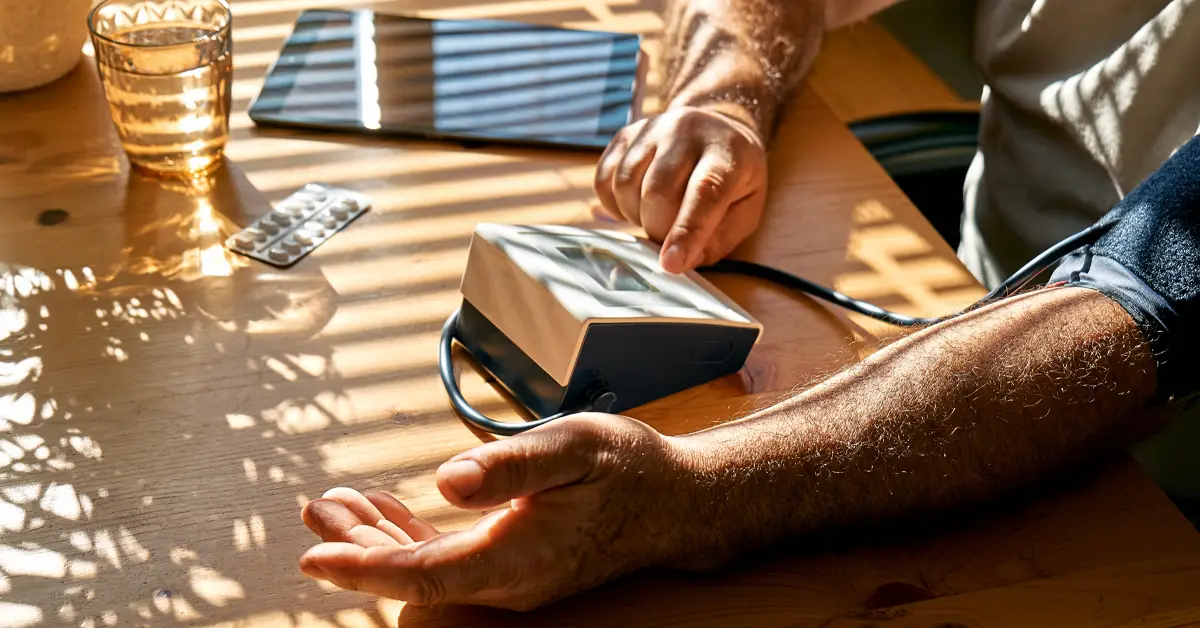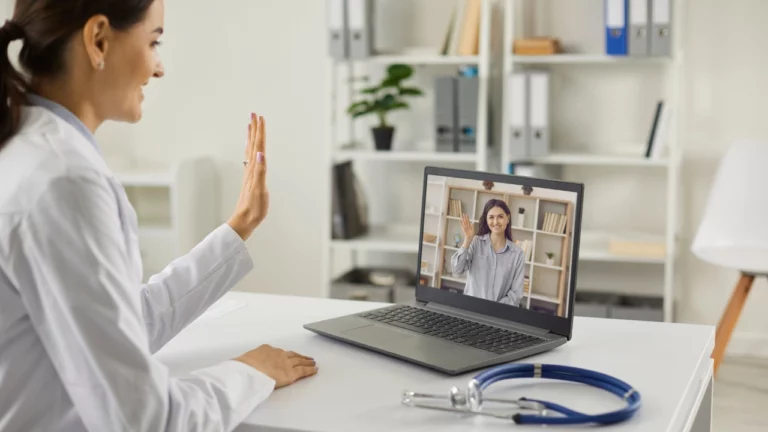According to Centers for Disease Control and Prevention (CDC), nearly 50 percent of U.S. adults have hypertension, a condition that can be tracked and managed. . The products and services provided by remote patient monitoring systems can track and manage hypertension to help patients maintain their health.
Blood pressure, the force of blood against the walls of the arteries, is an essential vital sign that reflects the functioning of the heart and blood vessels. High blood pressure or hypertension, can lead to serious health issues such as heart disease and stroke. To ensure optimal health, it is important to monitor blood pressure regularly.
Monitoring blood pressure at home is a convenient and easy way to keep track of your blood pressure readings and provide your healthcare provider with accurate data to help them manage your health. One of the best ways to monitor your blood pressure at home is by using a connected-health blood pressure monitor for RPM. This allows for easy access to your blood pressure readings and improved communication with your healthcare provider.
In this article, we will discuss the benefits of connecting blood pressure monitors to remote patient monitoring systems and how to choose the best blood pressure monitor for your needs.
Benefits of Connecting Blood Pressure Monitors to Remote Patient Monitoring Systems
1.) The convenience of monitoring blood pressure at home
With a connected blood pressure monitor, patients can easily measure their blood pressure at home and share the results with their healthcare provider. This eliminates the need for frequent office visits for blood pressure checks, allowing more frequent monitoring.
2.) Ability to track and record blood pressure readings over time
Remote patient monitoring systems store blood pressure readings and allow for tracking of patterns and trends over time. This can provide valuable information for healthcare providers to make adjustments to treatment plans.
3.) Easy access to blood pressure readings for healthcare providers
Connected blood pressure monitors allow for real-time access to blood pressure readings for healthcare providers. This can help them make more informed decisions about treatment and can lead to faster interventions if necessary.
4.) Improved communication and monitoring of hypertension
Connecting blood pressure monitors to remote patient monitoring systems can improve communication between patients and healthcare providers. This can lead to more effective management of hypertension and can help prevent serious health complications.
Choosing the Best Blood Pressure Monitor
Types of monitors available
When it comes to monitoring your blood pressure at home, there are several options available. One popular choice is a wrist blood pressure monitor; however, the American Heart Association recommends using an upper arm blood pressure monitor. This is because upper arm monitors have been found to be more accurate than wrist monitors.
There are also two other main types of monitors to choose from:
Manual blood pressure monitors, also known as aneroid monitors, use a cuff and a stethoscope to measure blood pressure. They are often small, portable, and relatively inexpensive. However, they do require more skill to use and may not be as accurate as automatic monitors.
Automatic blood pressure monitors, also known as digital monitors, use an inflatable cuff and electronic sensors to measure blood pressure. They are easy to use, accurate, and often come with additional features such as averaging multiple readings, and the ability to store data.
Features to look for in a blood pressure monitor
When purchasing a blood pressure monitor, there are several features you should consider to ensure you get an accurate and reliable device.
- Cuff size: The cuff should fit comfortably around your upper arm. If the cuff is too small, it will give a falsely high reading, and if it’s too large, it will give a falsely low reading.
- Accuracy: Look for monitors that have been validated by organizations such as the American National Standards Institute (ANSI) or the British Hypertension Society (BHS).
- Averaging: Some monitors can average multiple readings, which can be helpful if your blood pressure tends to fluctuate.
- Data storage: Some monitors can store your blood pressure readings, which can be helpful for tracking your progress and sharing with your healthcare provider.
- Ease of use: Look for a monitor that is easy to use and understand.
Basically, when choosing a blood pressure monitor, it is important to select one that is easy to use and read. The cuff should fit properly and the device should have a limited warranty. Additionally, having a monitor with smartphone connectivity can make it easy to track your health over time.
Recommendations from healthcare professionals and organizations
It’s important to consider the recommendations from healthcare professionals and organizations such as American Heart Association or your pharmacist. They can provide valuable insight on the best blood pressure monitors available and can help you make an informed decision.
Using and Maintaining a Home Blood Pressure Monitor
When using a blood pressure monitor, it is important to follow the manufacturer’s instructions and to take two or three readings per measurement. The readings should be taken at least one week before your next appointment with a healthcare professional. This will give you a good idea of your blood pressure trends and allow you to discuss any concerns with your healthcare provider.
It is also important to note that self-measured blood pressure should be used as a supplement to regular checkups with a healthcare professional. Blood pressure devices are not perfect and may not provide accurate results for everyone. Additionally, people with high blood pressure should consult with their healthcare professional about the best method for monitoring their blood pressure.
The following are tips on how to measure your blood pressure and maintain a home monitor:
Proper use of the cuff and monitor
To ensure accurate readings, it’s important to follow the instructions for properly using the cuff and monitor. This includes making sure the cuff is the correct size for your arm and positioning it correctly on your upper arm or wrist.
Tips for accurate readings
To get accurate readings, it’s recommended to take blood pressure measurements at the same time every day, avoid caffeine or smoking before taking a measurement, and to sit quietly for at least 5 minutes before taking the measurement.
Importance of validating readings with healthcare provider
It’s important to validate your blood pressure readings with your healthcare provider. They can help you interpret the readings and can check for any irregularities.
Maintenance and care of the monitor
To ensure accurate and consistent readings, it’s important to properly maintain and care for the monitor. This includes cleaning the cuff and monitor regularly and storing it in a dry place. It’s also important to check the battery level and replace it if necessary. It’s also important to check the manual and follow the manufacturer’s instructions for the device.
Understanding Blood Pressure Readings
Your blood pressure reading is given in two numbers, such as 120/80 mmHg. The first number, known as the systolic pressure, measures the force of blood against your artery walls when your heart beats. The second number, known as the diastolic pressure, measures the force of blood against your artery walls when your heart is at rest.
A normal blood pressure reading is considered to be below 120/80 mmHg. If your systolic pressure is between 120-129 mmHg and your diastolic pressure is less than 80 mmHg, you are considered to have elevated blood pressure. If your systolic pressure is 130 mmHg or higher and/or your diastolic pressure is 80 mmHg or higher, you have hypertension.
To learn more about how to measure your blood pressure, you may check Centers for Disease and Preventions’ guide.
Monitoring Blood Pressure Remotely: Drkumo RPM Technology
When it comes to monitoring your blood pressure at home, DrKumo offers a cutting-edge solution that is both reliable and user-friendly. The DrKumo Remote Patient Monitoring (RPM) technology is designed to solve the most painful problems in healthcare with a user-friendly solution that is powered by our state-of-the-art, HIPAA-compliant, mobile-enabled, continuous real-time monitoring, and AI/ML engine.
The American Heart Association (AHA) recommends using an upper arm cuff for self-measured blood pressure, and DrKumo RPM technology is equipped with an upper arm cuff that fits properly, allowing for accurate readings. DrKumo’s wireless, easy-wrap, and battery operated cuff allows patients to take their blood pressure at home and check their blood pressure on a regular basis. Additionally, the device has a built-in feature that allows patients to upload the readings to their healthcare professional, so they can determine whether there is cause for concern.
DrKumo’s RPM technology is highly scalable, continuous, and real-time, making it the perfect solution for Chronic Disease Management, Acute Care, Post-Operation, and Hospital Care at Home. DrKumo’s state-of-the-art, HIPAA-compliant, mobile-enabled, continuous real-time monitoring, and AI/ML engine provide a user-friendly experience for patients and healthcare providers alike.
It is important to use the device and take readings at the same time every day, and to take two or three readings per measurement, at least one week before your next appointment with a healthcare professional. This will give you a good idea of your blood pressure trends and allow you to discuss any concerns with your healthcare provider. With Drkumo’s RPM technology, healthcare providers can remotely monitor the health conditions of their patients at home, including blood pressure. This allows healthcare providers to provide more comprehensive care to their patients, and to intervene in a timely manner if necessary.
The information provided on this website is for informational purposes only and is not intended as a substitute for professional medical advice, diagnosis, or treatment. Always seek the advice of a qualified healthcare provider with any questions you may have regarding a medical condition. Never disregard professional medical advice or delay in seeking it because of something you have read on this website.
Takeaways
Connecting blood pressure monitors to RPM systems can greatly benefit patients by providing them with the convenience of monitoring their blood pressure at home. With easy access to blood pressure readings, healthcare providers can make more informed decisions about treatment which can lead to faster interventions if necessary. To ensure accurate readings, it’s important to choose the best blood pressure monitor for your needs and to properly use and maintain it. This includes following the instructions for proper use, validating readings with a healthcare provider, and cleaning and storing the monitor correctly.
It’s also important to check your blood pressure regularly and to take your blood pressure at the same time every day. To get accurate readings, avoid caffeine or smoking before taking a measurement, and sit quietly for at least 5 minutes before taking the measurement. It’s also essential to involve your healthcare professional in monitoring your blood pressure, they can help you interpret the readings, check for any irregularities and recommend the right cuff size that fits you.
Ultimately, the blood pressure monitor you choose and the way you use it can greatly impact your health. Consult with your medical professional, and choose a monitor from a reputable retailer that fits your needs and that you can use easily.
If you’re looking to take control of your blood pressure and improve your overall health using RPM technology solutions, contact DrKumo now.








